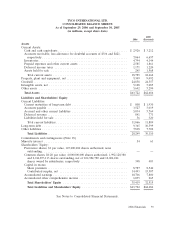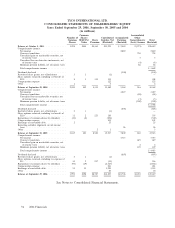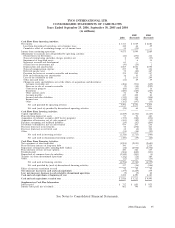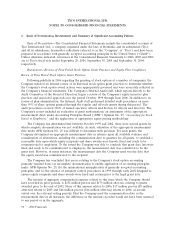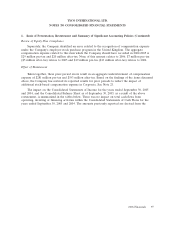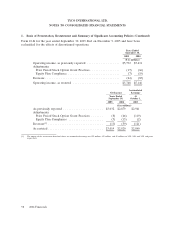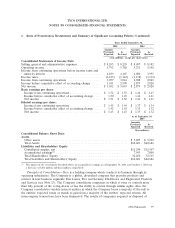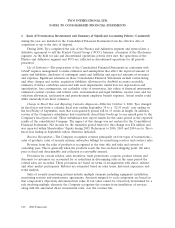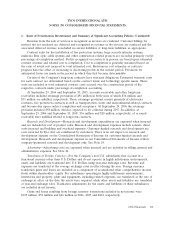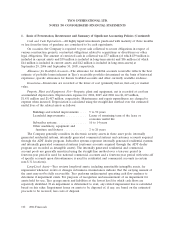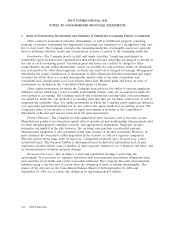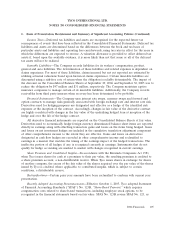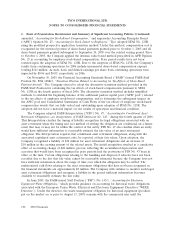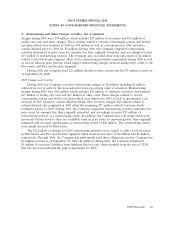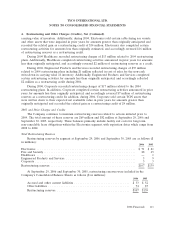ADT 2006 Annual Report Download - page 165
Download and view the complete annual report
Please find page 165 of the 2006 ADT annual report below. You can navigate through the pages in the report by either clicking on the pages listed below, or by using the keyword search tool below to find specific information within the annual report.TYCO INTERNATIONAL LTD.
NOTES TO CONSOLIDATED FINANCIAL STATEMENTS
1. Basis of Presentation, Restatement and Summary of Significant Accounting Policies (Continued)
Goodwill and Intangible Assets—Goodwill and indefinite-lived intangible assets are assessed for
impairment annually and more frequently if a triggering event occurs. In making this assessment,
management relies on a number of factors including operating results, business plans, economic
projections, anticipated future cash flows, and transactions and market place data. There are inherent
uncertainties related to these factors and judgment in applying them to the analysis of goodwill
impairment. The Company performed its annual impairment test in the fourth quarter of 2006 and no
impairment occurred.
When testing for goodwill impairment, first, the Company performs a step I goodwill impairment
test to identify a potential impairment. In doing so, the Company compares the fair value of a
reporting unit with its carrying amount. If the carrying amount of a reporting unit exceeds its fair value,
goodwill is considered impaired and a step II goodwill impairment test is performed to measure the
amount of impairment loss. In the step II goodwill impairment test, the Company compares the implied
fair value of reporting unit goodwill with the carrying amount of that goodwill. If the carrying amount
of reporting unit goodwill exceeds the implied fair value of that goodwill, an impairment loss is
recognized in an amount equal to that excess. The implied fair value of goodwill is determined in the
same manner that the amount of goodwill recognized in a business combination is determined. The
Company allocates the fair value of a reporting unit to all of the assets and liabilities of that unit,
including intangible assets, as if the reporting unit had been acquired in a business combination. Any
excess of the value of a reporting unit over the amounts assigned to its assets and liabilities is the
implied fair value of goodwill.
Amortizable Intangible Assets, Net—Intangible assets primarily include contracts and related
customer relationships, and intellectual property. Certain contracts and related customer relationships
result from purchasing residential security monitoring contracts from an external network of
independent dealers who operate under the ADT dealer program. Acquired contracts and related
customer relationships are recorded at their contractually determined purchase price. The Company
incurs costs associated with maintaining and operating its ADT dealer program, including brand
advertising and due diligence, which are expensed as incurred.
During the first six months (twelve months in certain circumstances) after the purchase of the
customer contract, any cancellation of monitoring service, including those that result from customer
payment delinquencies, results in a chargeback by the Company to the dealer for the full amount of
the contract purchase price. The Company records the amount charged back to the dealer as a
reduction of the previously recorded intangible asset.
Intangible assets arising from the ADT dealer program described above are amortized in pools
determined by the month of contract acquisition on an accelerated basis over the period and pattern of
economic benefit that is expected to be obtained from the customer relationship. Based upon analyses
of the period and pattern of economic benefit associated with the intangibles, which utilize information
contained in attrition studies of the ADT dealer program customer base, conducted by a third party
appraiser, the Company believes that the accelerated method that presently best achieves the matching
objective above is the double-declining balance method based on a ten-year life for the first eight years
of the estimated life of the customer relationship, converting to the straight-line method of
amortization for the remaining four years of the estimated relationship period. Actual attrition data is
regularly reviewed in order to assess the continued appropriateness of the accelerated method of
amortization described above.
103
2006 Financials


